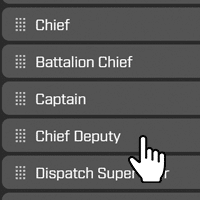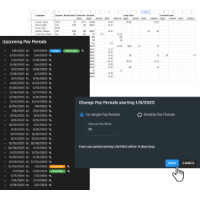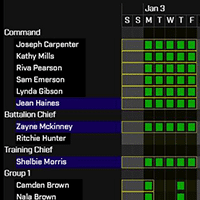Shift Types
Rotating, fixed and split shifts.
Hero Schedule is designed around many types of shift-based schedules. Each shift style has it's own settings and parameters that can be set up within the system. Whether you use fixed shifts, rotating shifts, split shifts or some combination of all three – Hero Schedule will help you keep it all straight.
Common shift types Hero Schedule can manage
Rotating shifts
Rotating shifts are when employees are scheduled for alternating shifts and hours through the week. This is done to give employees a balance of shifts to help better align doctors appointments, family obligations, etc. Several of the common rotating shifts that work with Hero Schedule are below – but if you have a unique rotating shift not listed, talk to us and we can customize the software to your exact needs.
12-hour shift
12-hour shifts can be managed in Hero Schedule. Common uses cases are for the 4-on, 4-off fixed shift schedule. Many of our 12-hour shift types are considered rotating due to their length.
24-hour shift
The most common fixed 24-hour shift schedule is the 24-48, used in fire department shift scheduling. This means an employee (in this case, firefighter) would work a 24-hour shift, followed by 48 hours off.
Pitman shift (or variations)
Agencies that use a 2-3-2 or 2-2-3 shift scheduling can be applied in Hero Schedule. All Pitman shifts are 12-hours in length and run on a 14-day shift cycle.
DuPont shift
DuPont shifts usually operate with 12-hour shifts with a rotating schedule. This is based on four "teams" of employees working alternating shift cycles.
Southern Swing shift
The Southern Swing schedule rotates employees on an 8-hour schedule over a 28-day shift cycle. In the case of a department or agency, you would have four "groups" or "teams" working each shift through a 28-day period.
California Swing shift
The California Swing Shift is often used in firefighting. It is a version of the 24-hour schedule, but with a twist. Employees work 5 consecutive days of alternating 24-hours on and 24-hours off. This is followed by 96 hours off (4 days).
2-2-3 shift
The 2-2-3 shift is a 12-hour shift that rotates on the 28-day scheduling cycle.
Portland schedule
This is a 1-3-2-3 pattern for 24-hour shifts. Firefighters work 1 day (24 hours), are off 3 days, work 2 days (48 hours), then are off 3 days. This originated with Portland Fire & Rescue.
Other rotating shifts
We can adopt every type of rotating shift that your agency uses. When we get on a demo call, we can demonstrate how this works with our schedule system.
Fixed shifts, Split shifts & On-call
Fixed shifts are standard shifts that do not rotate or change each week. Split shifts divide an employee's hours into two parts. These schedule types (regardless of shift length) are easily managed in Hero Schedule.
8-hour shift
Standard 8-hour shifts are very easy to set up in Hero Schedule. These are usually for employees with 40 hour workweeks and standard 5 days on, 2 days off schedules. Very good for support staff, investigators, and more.
10-hour shift
The 10-hour shift is often used in conjunction with a 4-on, 3-off schedule structure (also known as 4/10 schedule). Hero Schedule can help you manage your agency if you use this type of fixed schedule.
Split shift
Split shifts divide an employee's hours into two parts.
An example of a split shift: Work 0730 to 1200, take lunch from 1200 to 1300, work 1300 to 1630.
On-call
On-call shifts are used when an employee can be called in to work at a moment's notice. This is commonly used with law enforcement investigators. On-call shifts also accrue credit, oftentimes in the form of Comp Time.



